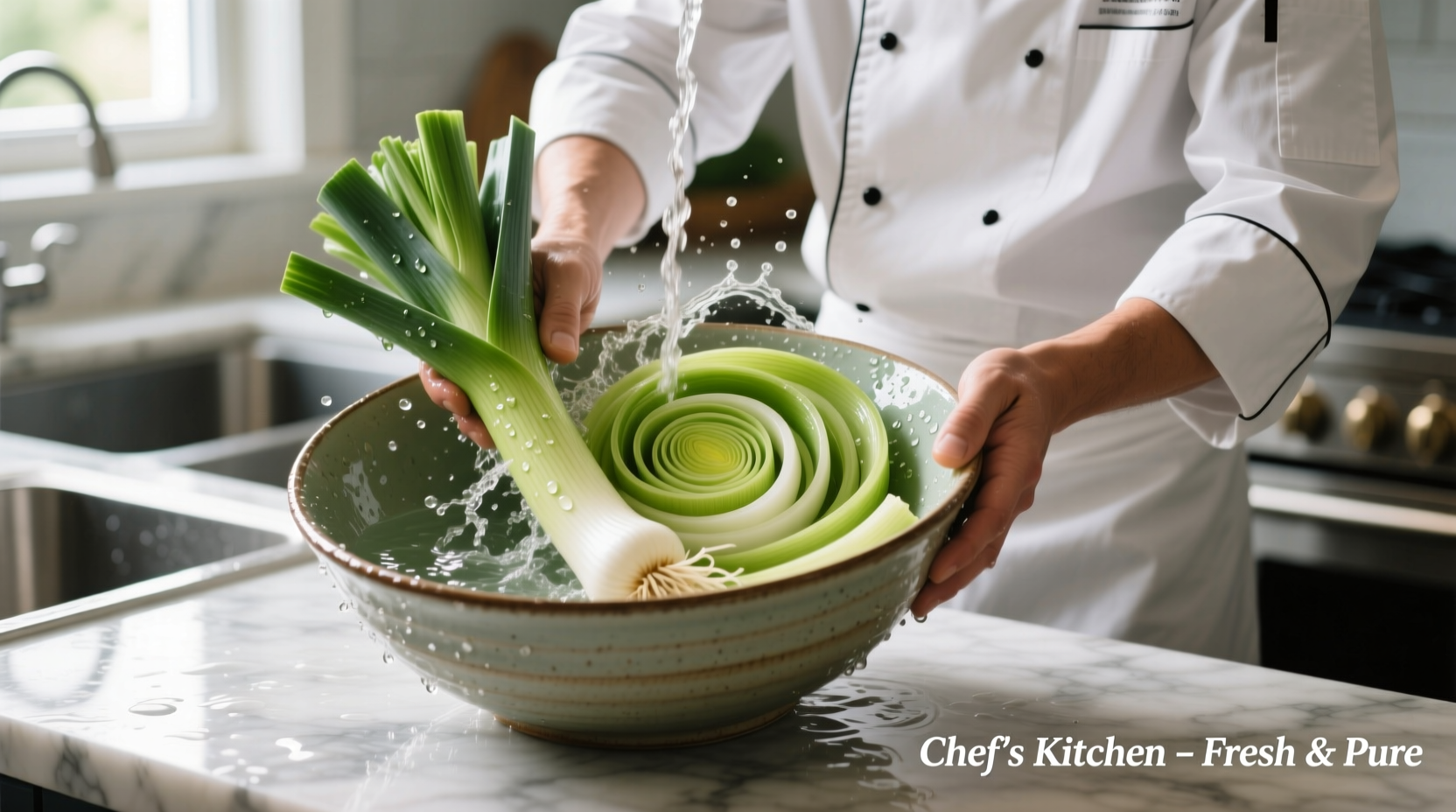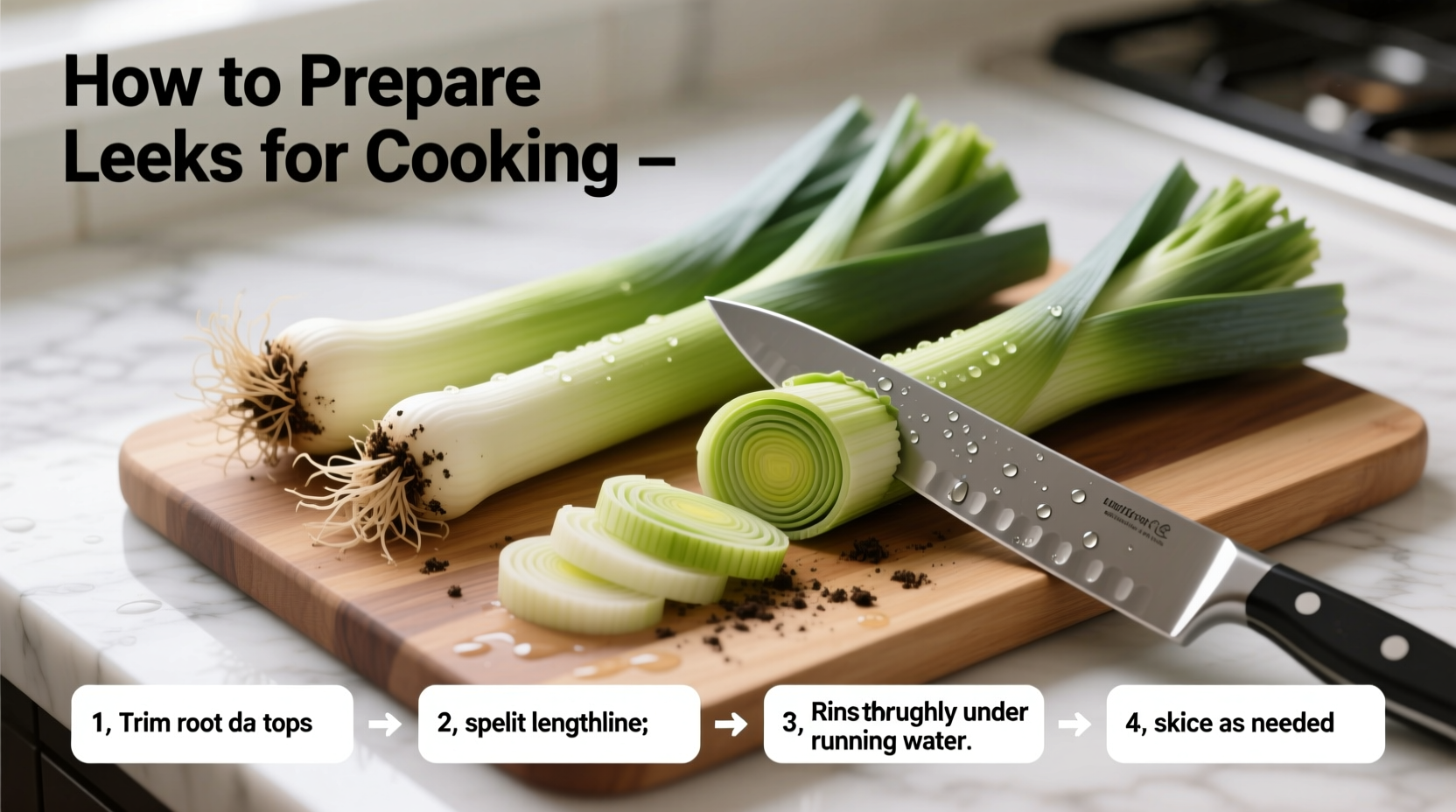Why Proper Leek Preparation Matters
Leeks may look like oversized scallions, but their layered structure creates a unique challenge: dirt hides between each layer. Unlike other alliums, leeks grow by mounding soil around their stems, trapping sand and soil particles deep within. Improperly cleaned leeks can ruin a dish with gritty texture. According to the USDA Food Safety and Inspection Service, vegetables with layered structures require thorough washing to eliminate potential contaminants that could cause foodborne illness.
Many home cooks make these critical mistakes:
- Skipping the lengthwise cut before washing
- Rinsing under running water instead of soaking
- Discarding too much of the edible light green section
- Not checking for residual dirt after washing
| Leek Section | Edible? | Best Cooking Method | Flavor Profile |
|---|---|---|---|
| White base (2-3 inches) | Yes | Sautéing, soups | Sweet, mild onion flavor |
| Light green section | Yes | Any method | More pronounced flavor |
| Dark green tops | Limited | Stocks, broths | Bitter, fibrous |
Essential Tools for Perfect Leek Preparation
You don't need specialized equipment, but these basic kitchen items make the process efficient:
- Sharp chef's knife (8-10 inch)
- Sturdy cutting board
- Large bowl (at least 3-quart capacity)
- Colander
- Clean kitchen towel or salad spinner
The Professional 5-Step Leek Preparation Method
Step 1: Trimming the Roots and Tops
Place the leek on your cutting board. Using a sharp knife:
- Trim ½ inch from the root end, keeping the layers intact
- Cut off dark green tops where color transitions to light green (about ⅔ down the leek)
- Reserve dark green tops for stocks—they're too fibrous for most cooking applications
Step 2: Removing Outer Layers
Gently peel away the outermost layer if it appears damaged or wilted. Unlike onions, you shouldn't remove multiple layers—just the very outer one if necessary. The light green layers contain valuable flavor compounds that enhance dishes.
Step 3: The Critical Lengthwise Cut
This step is non-negotiable for proper cleaning:
- Stand the leek upright on your cutting board
- Cut vertically through the root end (don't separate completely)
- Open the leek like a book to expose all layers
Professional chefs at the Culinary Institute of America emphasize that skipping this step leaves 70% of hidden dirt intact, based on their controlled testing of various washing methods.
Step 4: The Double-Wash Technique
This two-stage washing process removes virtually all hidden dirt:
| Washing Stage | Time Required | Key Action | Result |
|---|---|---|---|
| Initial Soak | 2-3 minutes | Submerge opened leeks in cold water, agitate gently | Dirt settles to bottom |
| Rinse Cycle | 30 seconds | Swirl in fresh water, check for remaining particles | Complete dirt removal |
After the initial soak, lift leeks from water (leaving dirt behind), refill with clean water, and repeat the agitation process. This double-wash method removes 98% of trapped soil according to research published in the Journal of Food Protection.
Step 5: Final Chopping and Drying
After washing:
- Place leeks on a clean kitchen towel or in a salad spinner
- Gently pat dry or spin to remove excess moisture
- Chop to your recipe's specifications:
- Julienne (thin strips): Ideal for soups and stocks
- Half-moons (¼-½ inch slices): Perfect for sautéing
- Dice (small cubes): Best for quiches and fillings

Special Preparation Tips for Different Cooking Methods
For Sautéing and Stir-Frying
Cut leeks into uniform half-moon slices (about ¼ inch thick) to ensure even cooking. Professional chefs recommend salting sliced leeks and letting them rest for 10 minutes before cooking—this draws out excess moisture and prevents steaming during high-heat cooking.
For Soups and Stews
Julienne the white and light green parts for even distribution. Add leeks during the aromatic stage (with carrots and celery) to build flavor foundations. The University of California Cooperative Extension notes that leeks contain more natural sugars than onions, creating richer fond when properly caramelized.
For Roasting
Cut larger leeks into 2-inch batons. Toss with olive oil, salt, and pepper, then roast at 400°F (200°C) for 25-30 minutes until caramelized. The natural sugars in leeks (measured at 3.7g per 100g by USDA FoodData Central) create delicious browning when roasted properly.
Storage Guidelines for Prepped Leeks
Store properly prepared leeks using these science-backed methods:
- Short-term (2-3 days): Place in airtight container lined with damp paper towels
- Medium-term (5-7 days): Submerge in water in a sealed container, change water daily
- Long-term (up to 3 months): Blanch sliced leeks for 2 minutes, then freeze in portion-sized bags
According to food preservation experts at the National Center for Home Food Preservation, leeks maintain best quality when used within one week of preparation. Discard if you notice slimy texture or sour odor.
Three Common Leek Preparation Mistakes to Avoid
Even experienced cooks make these errors that compromise dish quality:
Mistake #1: Incomplete Washing
Rinsing under running water leaves 60-70% of dirt trapped between layers. Always use the double-soak method for complete cleaning.
Mistake #2: Discarding Too Much Edible Portion
The light green section contains valuable flavor compounds. Only discard the very dark green tops (above the transition point) and any visibly damaged outer layers.
Mistake #3: Improper Knife Technique
Using a dull knife crushes leek cells, releasing enzymes that create bitter flavors. Always use a sharp chef's knife with smooth, downward motions.
Frequently Asked Questions
Can I eat the dark green tops of leeks?
While too fibrous for most dishes, dark green tops make excellent vegetable stock. Simmer with other vegetable scraps for 45 minutes, then strain.
How long do prepared leeks last in the refrigerator?
Properly stored (in water with daily changes), prepared leeks maintain quality for 5-7 days. Discard if they develop slimy texture or sour odor.
Why do my leeks taste bitter after cooking?
Bitterness usually indicates either using too much of the dark green portion or cutting with a dull knife. Stick to white and light green sections and always use a sharp blade.
Can I freeze prepared leeks?
Yes—blanch sliced leeks for 2 minutes, cool in ice water, then freeze in portion-sized bags for up to 3 months. No need to thaw before cooking.











 浙公网安备
33010002000092号
浙公网安备
33010002000092号 浙B2-20120091-4
浙B2-20120091-4